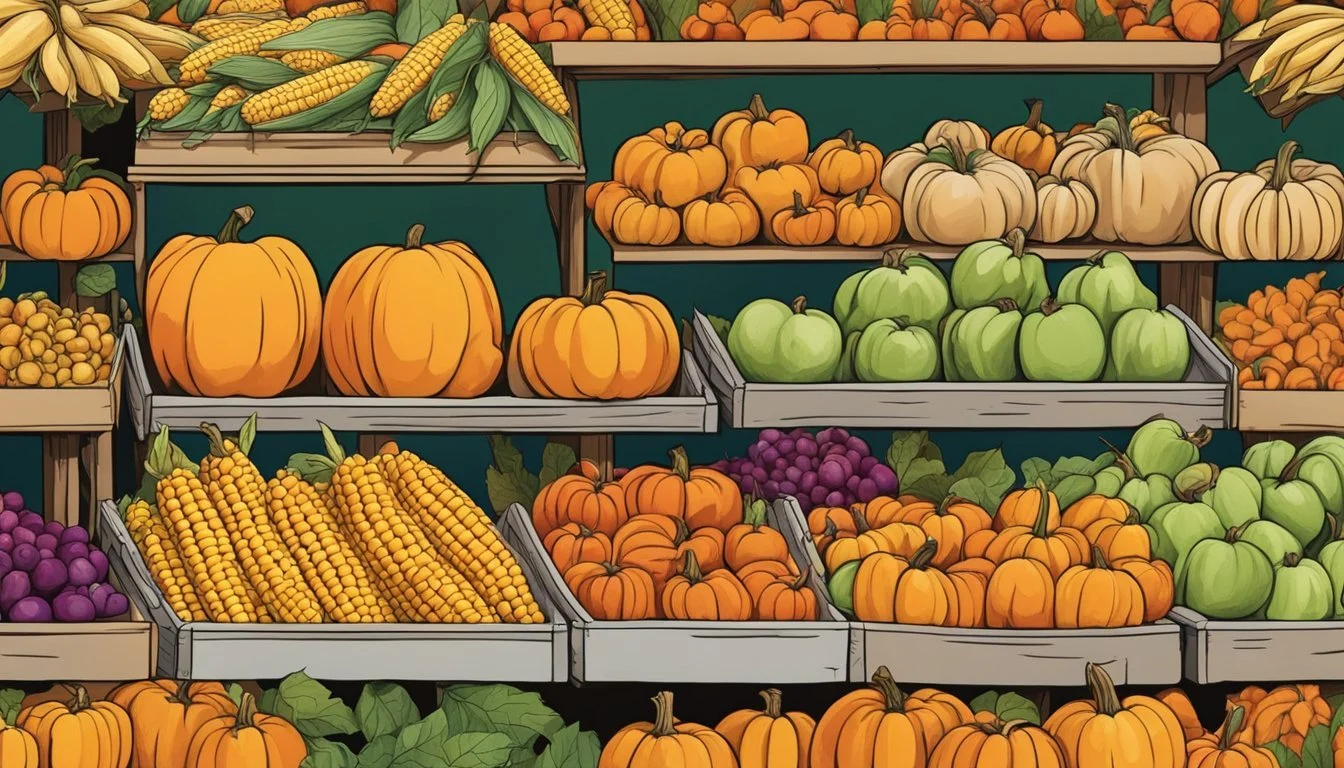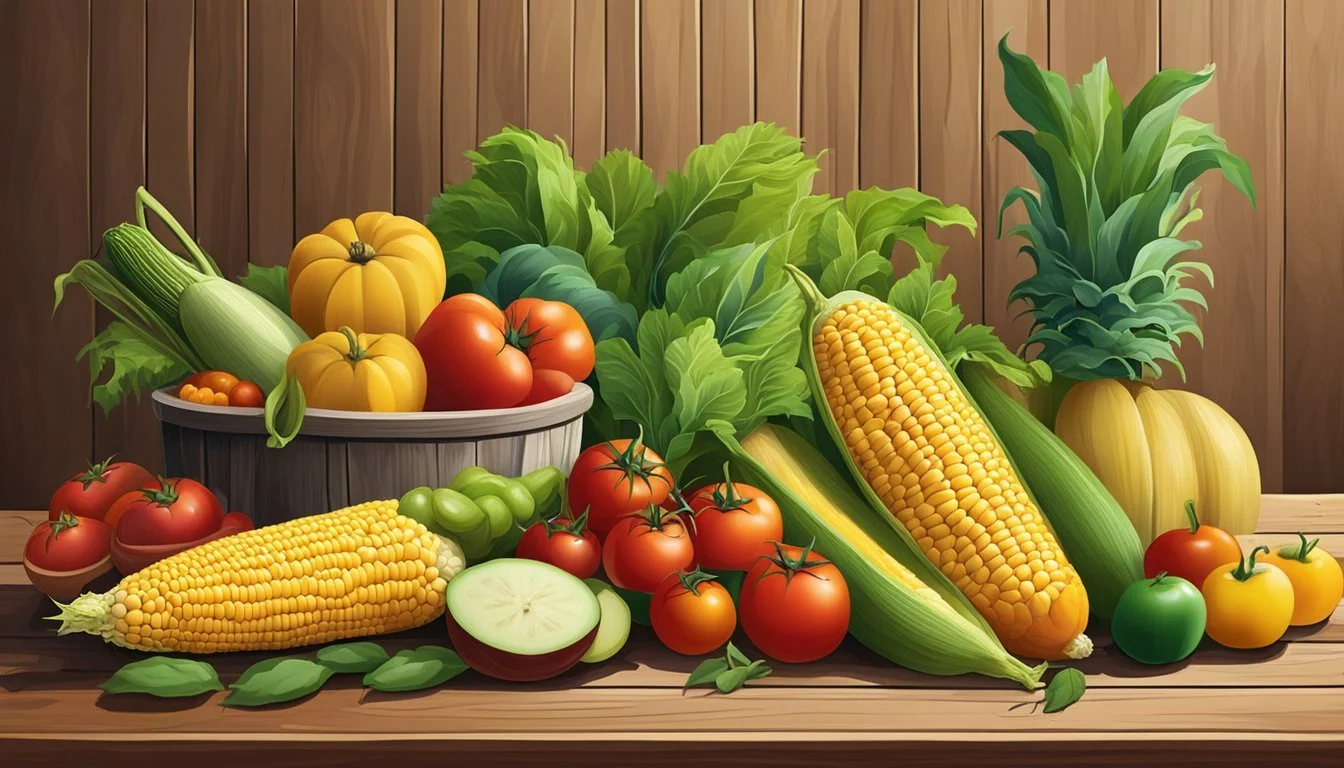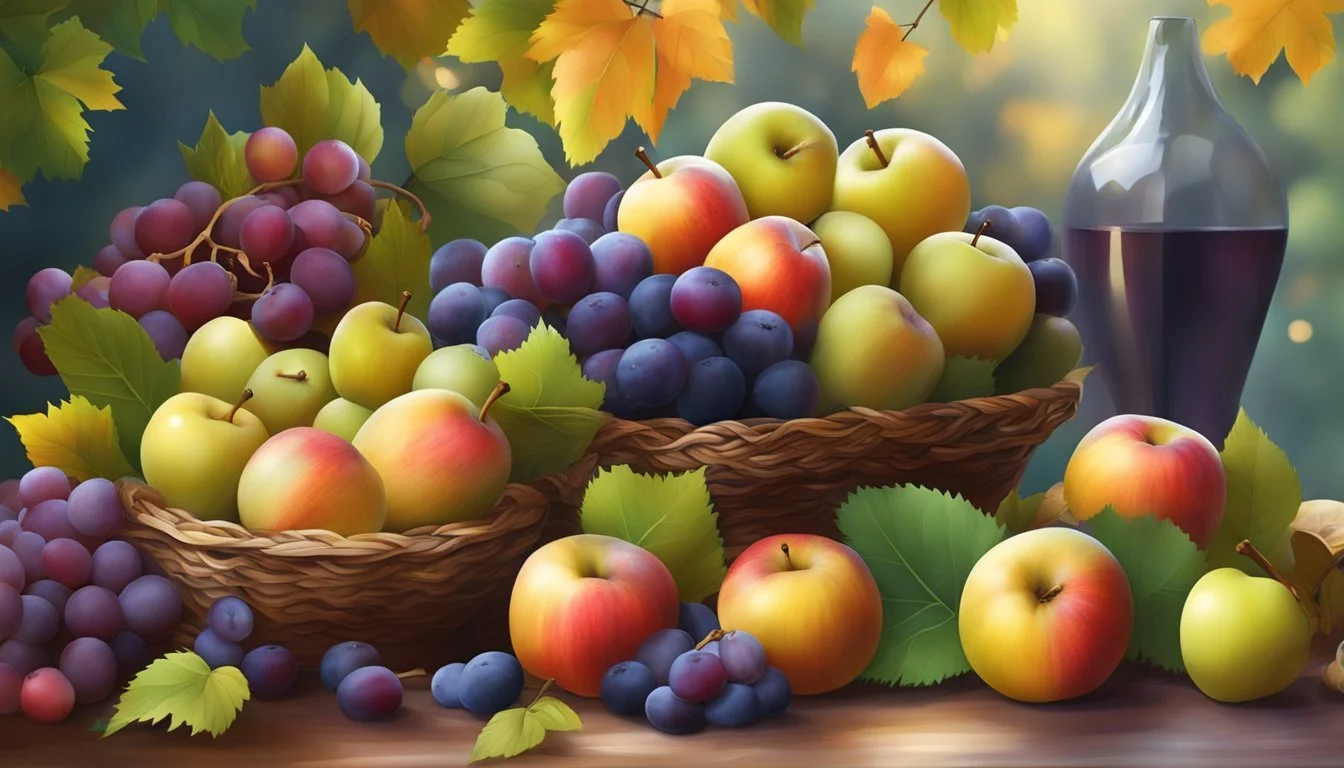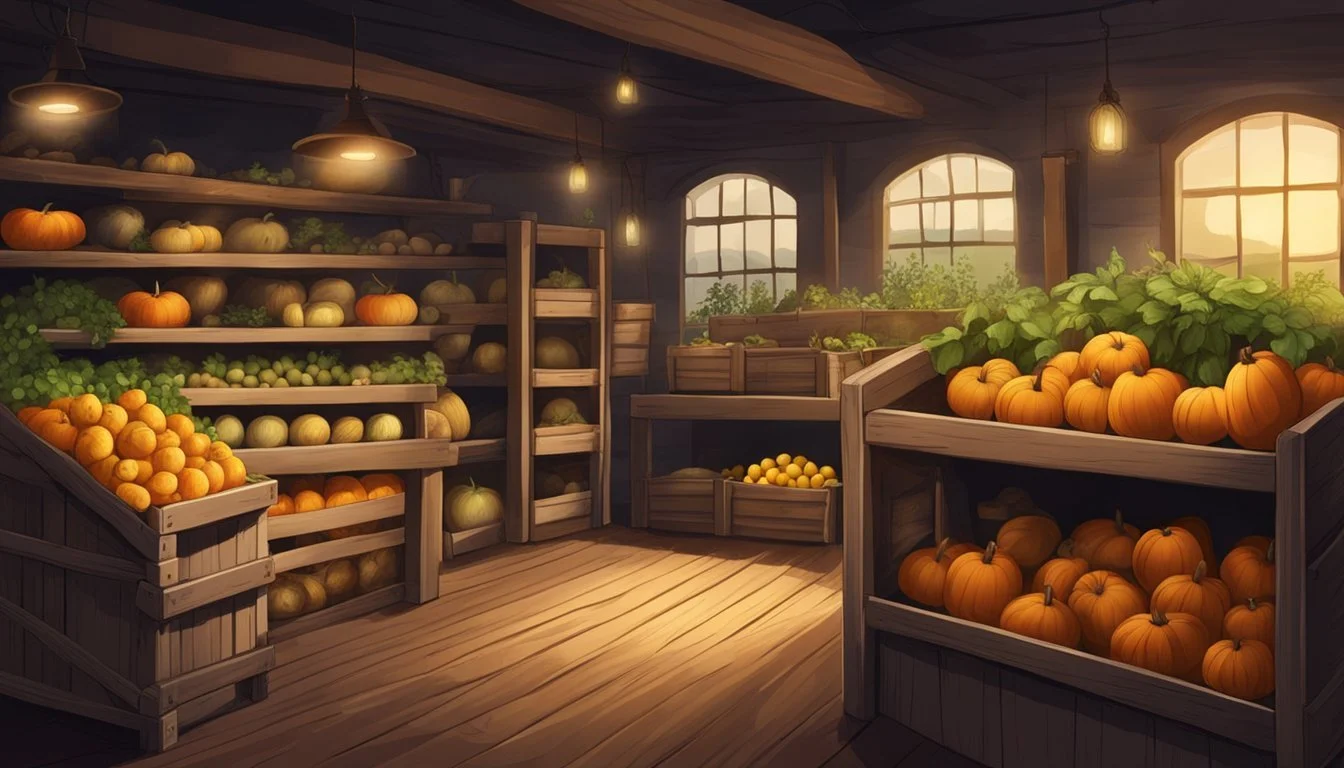Minnesota Seasonal Fruit & Vegetables in September
Your Ultimate Guide
This Article is Part of our Minnesota Seasonal Fruit & Veg Calendar
In Minnesota, September marks a transitional period where the tail end of summer's bounty meets the beginning of autumn's harvest. This is a time when farmers' markets and backyard gardens are abundant with a variety of produce. The harvest in September includes fruits like grapes, which have had the benefit of the full warm season to ripen to perfection, and vegetables such as green beans, which are often at their peak. The cooler early fall temperatures also allow for the optimal growth of various greens and lettuces, providing a fresh, crisp ingredient palette for salads and sides.
The region's seasonal calendar highlights September as a month rich in diversity for fruits and vegetables. It is an excellent month for Minnesotans to enjoy locally-sourced, fresh produce, as the array of available items is vast. Greens of many kinds, flavorful herbs, robust root vegetables like leeks, and a selection of greens are ready for harvest, ensuring that local cuisine can be both vibrant and varied. The tradition of celebrating the harvest can be seen in local recipes and food fairs that make the most of September's seasonal offerings.
Adapting culinary practices to the rhythm of the seasons allows for not only the freshest flavors but also supports sustainable agriculture and local economies. In Minnesota, the commitment to seasonal eating in September encourages a connection to the land and the cycles of nature. For consumers, this means access to produce that is at its nutritional and flavorful peak, perfect for creating hearty meals as the days begin to shorten and the air turns crisp.
Overview of Minnesota's Growing Season
Minnesota's climate presents a distinctive growing season that is especially notable for its clear transition between the warm summers and cooler falls. Summer in Minnesota typically brings about a range of harvest times, allowing a variety of crops to thrive. As summer transitions to fall, certain crops become readily available, capitalizing on the state's seasonal changes.
During the warmer months, farmers focus on crops that demand more heat, and as temperatures begin to drop, they switch gears to accommodate the change in weather. Fall in Minnesota is a crucial period for harvesting several types of produce before the onset of the frost. The harvest times during this season are characterized by an urgency to gather crops at their peak freshness and flavor.
The crop availability in September, for instance, showcases a diverse assortment of fruits and vegetables. Here's a brief snapshot of Minnesota's crop availability during this month:
Fruits: Grapes are in season.
Vegetables: Options are plentiful, including:
Green beans
Greens (various types)
Herbs (various types)
Leeks
Lettuce (various types)
The impact of the seasons is seen not just in what is grown but also in how the seasons bring about a shift in farming strategies. Summer crops are phased out, and those that fare better in cooler weather are emphasized. Cultivators adeptly navigate these transitions to extend the productivity of their land through to the end of the harvest times in October.
September's Seasonal Produce Highlights
Minnesota's September brings in a bounty of fresh produce that is well-suited for the cooling temperatures. Farmers' markets and grocery stores brim with locally grown options.
Apples are the stars of the season, with several varieties ripening during this month. From tart selections like the Haralson to sweet choices such as Honeycrisp, apples are versatile in both sweet and savory dishes.
Tomatoes continue to thrive in September. They range from large, juicy beefsteaks perfect for sandwiches to petite cherry tomatoes ideal for salads. Their flavor is at its peak, making this the best time to enjoy them fresh.
Grapes, another fruit that reaches maturity in early fall, come in a variety of types, including Concord and Itasca—suitable for raw snacking or wine-making endeavors.
Produce Description Uses Sweet Corn Crisp and tender kernels. Boiled, grilled, or in salads. Peppers Includes bell and spicy varieties. Stuffed, roasted, or in salsas.
Minnesota prides itself on 'sweet corn', a local favorite, which stays in high demand. Grilling corn brings out its inherent sweetness, perfect for late summer barbecues.
Peppers add a range of flavors and heat levels to dishes. Poblanos and jalapeños are common and can be fire-roasted or incorporated into traditional Southwestern recipes.
In summary, September in Minnesota is a time to relish the full flavors of produce as they transition from the light and zesty summer favorites to the more robust and hearty fall varieties.
Key Vegetables to Enjoy in September
September in Minnesota brings a bounty of vegetables to the table, each offering unique flavors and nutritional benefits. The fall harvest provides a variety of root vegetables, hearty squashes, and lush greens, making it an ideal time to explore the depth of seasonal produce.
Root Vegetables and Tubers
Root vegetables and tubers thrive in the cool Minnesota climate, making September a prime month for their harvest. Potatoes are versatile and can be found in numerous varieties, from starchy russets to waxy fingerlings. Beets, with their deep red hue and sweet flavor, add both color and taste to a variety of dishes. Carrots are another staple, known for their crisp texture and sweetness, which intensifies with cooking.
Radishes: They offer a peppery kick and are perfect for adding a fresh crunch to salads.
Potatoes: Utilize varieties like russets for baking or Yukon Golds for mashing.
Beets: Excellent roasted, boiled, or even raw for their earthy sweetness.
Carrots: Great for snacking, roasting, or in stews.
Squashes and Gourds
The array of squashes available in September is a true testament to the seasonal shift. From tender zucchini to the hard-shelled butternut squash (how long does butternut squash last?), gardeners and chefs alike celebrate their versatility. Butternut squash is particularly celebrated for its smooth texture and nutty flavor, making it a perfect ingredient for both savory and sweet dishes.
Squash: Includes varieties like acorn, delicata, and spaghetti, each with its own unique culinary uses.
Greens and Brassicas
As the weather begins to cool, greens and brassicas come into their own. Rich in nutrients, these vegetables add a hearty element to any meal. Kale, with its curly leaves and robust flavor, stands out as a superfood that can be enjoyed in salads or as a cooked green. Cabbage is another versatile vegetable, ideal for slaws or fermented to make sauerkraut (how long does sauerkraut last?). Lastly, broccoli is a cruciferous vegetable that is both nutrient-dense and suitable for steaming, roasting, or stir-frying.
Kale: Best when the leaves are dark green and can be used in everything from salads to chips.
Cabbage: Look for firm heads and use it fresh, cooked, or preserved.
Broccoli: Choose bunches with tight, dark green florets for the best flavor and texture.
Fruit Varieties Available in September
In September, Minnesota's orchards and farms are abundant with a variety of fruits ready for harvest. This month marks the peak season for several fruit types, each with distinct flavors and uses.
Apple Types and Uses
Minnesota is well-known for its apple production, with several popular varieties ripening in September.
Honeycrisp: Created at the University of Minnesota, this apple is crisp and sweet, ideal for eating fresh or using in salads.
Sweet Tango: Another Minnesota-bred apple, known for its crisp texture and a perfect balance of sweet and tangy flavors, suitable for snacking and baking.
Haralson: Tart and firm, this apple is excellent for pies and applesauce.
Berries and Small Fruits
Though berry season is winding down in September, some resilient varieties remain available.
Raspberries: These can often be found until the first frost, offering a sweet and slightly tart flavor perfect for jams, desserts, or eating fresh.
Concord Grapes: While not a berry, these small fruits become ripe in September, known for their bold, sweet flavor.
Stone Fruits and Melons
As summer transitions to fall, stone fruits and melons are harvested for the last time of the season.
Plums: Varieties such as the Stanley plum are harvested in September. They are juicy and sweet, suitable for fresh eating or making preserves.
Melons: Various types including honeydew and cantaloupe (how long does cantaloupe last?) may still be found, offering a sweet, hydrating treat as summer ends.
Preservation and Storage of September Produce
September in Minnesota brings a bounty of fruits and vegetables to the harvest table. Proper preservation and storage are vital to extending the shelf life of this fresh produce.
Apples: They should be kept in a cool, dry place away from more perishable fruits. Refrigeration can prolong their shelf life, ideally in a crisper drawer at around 32-40°F in the fridge. Apples can also be transformed into applesauce and then canned for longer shelf-life.
Tomatoes: Best kept at room temperature away from direct sunlight to ripen to their full flavor. Once ripe, they can be stored in the fridge to slow down spoilage. For longer storage, one can make salsa or tomato sauce and can them following proper canning procedures.
Grapes: They require refrigeration, preferably in a perforated plastic bag to maintain humidity. Grapes do not have a long shelf life, so they should be consumed quickly or be made into jam.
Green Beans: Should be stored in the refrigerator in a plastic bag. They can also be blanched and frozen, or pickled for longer storage.
Leafy Greens: These vegetables fare best in a fridge, stored in an airtight container to maintain moisture.
Herbs: Like green leafy vegetables, should be stored in the fridge, either wrapped in a damp paper towel or in an airtight container.
The table below summarizes the storage recommendations:
Produce Fridge Airtight Container Preservation Method Apples ✓ Applesauce, Canning Tomatoes ✓ (ripe) Salsa, Sauce, Canning Grapes ✓ Jam Green Beans ✓ Blanching and Freezing, Pickling Leafy Greens ✓ ✓ Herbs ✓ ✓
In conclusion, each type of produce has its ideal storage condition, and for those that don't last long even in ideal conditions, various preservation methods can be applied, like making jams, sauces, pickles, or storing them by canning.
September Harvest Festivals and Events
Minnesota is known for its vibrant harvest season in September. This period is bustling with various festivals that celebrate the state’s rich agricultural bounty. Gathering locals and visitors alike, these events are a testament to the hard work of growers and the fertility of Minnesota soil.
Twin Cities Harvest Festival - Located in Brooklyn Park, this festival is a family favorite with a cornucopia of activities and an array of fresh produce from local markets.
Dodge Center Harvest Fest - Dodge Center becomes a hub for enthusiasts of autumn's splendor. It features a weekend full of events reflecting the community’s spirit and dedication to the season’s harvest.
In many towns, farmers markets are at their peak, filled with the season's best. Here, one can find home-grown vegetables and fruits along with homemade goods. These markets not only provide a platform for local growers but also an opportunity for visitors to experience Minnesota's local flavors.
Event Location Highlights Twin Cities Harvest Festival Brooklyn Park, MN Corn maze, family activities Dodge Center Harvest Fest Dodge Center, MN Community events, local produce
September in Minnesota is not just a time of reaping the harvest but also celebrating the local agricultural heritage through these lively festivals and markets.
Cooking and Preparing September's Harvest
In September, Minnesota offers a bounty of fruits and vegetables perfect for a variety of cooking methods. One can enjoy them raw in salads, roasted to enhance their natural sugars, steamed for a healthy side, or incorporated into warming soups and hearty dishes.
Simple and Fresh Recipes
Salads: September's harvest presents a variety of fresh ingredients for salads. One can combine arugula with sliced apples, toasted walnuts, and a vinaigrette for a crisp, autumnal salad.
Raw: Vegetables such as bell peppers and cucumbers are crisp and flavorful when eaten raw and can be cut into sticks or slices for snacks or platters.
Preserving Techniques and Recipes
Canning: Preserve the flavors of September by canning tomatoes for sauces or making apple preserves.
Freezing: Berries and sweet corn can be frozen shortly after picking, which helps to lock in flavor and nutrients for use throughout the year.
Hearty Dishes for Cooler Evenings
Roasted: Roasted vegetables such as carrots, parsnips, and onions develop sweet, concentrated flavors and are an excellent side to any main course.
Soups: Squash and pumpkins can be pureed into creamy soups that embody the essence of fall and provide comfort on chilly evenings.









